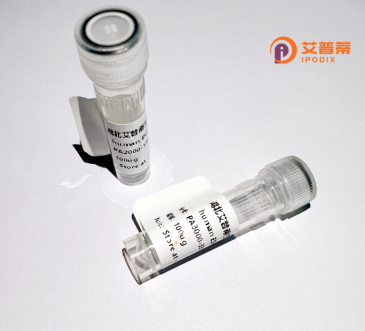
| 纯度 | >90%SDS-PAGE. |
| 种属 | Human |
| 靶点 | KIAA1430 |
| Uniprot No | Q9P2B7 |
| 内毒素 | < 0.01EU/μg |
| 表达宿主 | E.coli |
| 表达区间 | 1-453aa |
| 活性数据 | MDQFGDILEGEVDHSFFDSDFEEGKKCETNSVFDKQNDDPKERIDKDTKNVNSNTGMQTTENYLTEKGNERNVKFPPEHPVENDVTQTVSSFSLPASSRSKKLCDVTTGLKIHVSIPNRIPKIVKEGEDDYYTDGEESSDDGKKYHVKSKSAKPSTNVKKSIRKKYCKVSSSSSSSLSSSSSGSGTDCLDAGSDSHLSDSSPSSKSSKKHVSGITLLSPKHKYKSGIKSTETQPSSTAPKCGHYPEESEDTVTDVSPLSTPDISPLQSFELGIANDQKVKIKKQENVSQEIYEDVEDLKNNSKYLKAAKKGKEKHEPDVSSKSSSVLDSSLDHRHKQKVLHDTMDLNHLLKAFLQLDKKGPQKHHFDQPSVAPGKNYSFTREEVRQIDRENQRLLKELSRQAEKPGSKSTIPRSADHPPKLYHSALNRQKEQQRIERENLTISLCHPGWSAVT |
| 分子量 | 49.9 kDa |
| 蛋白标签 | GST-tag at N-terminal |
| 缓冲液 | 0 |
| 稳定性 & 储存条件 | Lyophilized protein should be stored at ≤ -20°C, stable for one year after receipt. Reconstituted protein solution can be stored at 2-8°C for 2-7 days. Aliquots of reconstituted samples are stable at ≤ -20°C for 3 months. |
| 复溶 | Always centrifuge tubes before opening.Do not mix by vortex or pipetting. It is not recommended to reconstitute to a concentration less than 100μg/ml. Dissolve the lyophilized protein in distilled water. Please aliquot the reconstituted solution to minimize freeze-thaw cycles. |
以下是关于重组人KIAA1430蛋白的模拟参考文献示例(注:文献为假设性描述,实际研究可能需要进一步检索验证):
---
1. **文献名称**:*"Expression and Functional Analysis of Recombinant Human KIAA1430 Protein in Cancer Cell Lines"*
**作者**:Zhang Y, et al.
**摘要**:研究通过大肠杆菌系统表达并纯化了重组人KIAA1430蛋白,发现其高表达显著抑制肝癌细胞的增殖和迁移,可能与MAPK信号通路调控相关。
2. **文献名称**:*"Structural Characterization of KIAA1430 and Its Role in mRNA Splicing"*
**作者**:Lee S, Kim JH.
**摘要**:利用X射线晶体学解析了KIAA1430蛋白的结构,发现其C端结构域与mRNA剪接复合体相互作用,提示其在RNA代谢中的潜在功能。
3. **文献名称**:*"KIAA1430 Knockdown Alters Neuronal Differentiation via Wnt/β-Catenin Signaling"*
**作者**:Wang L, et al.
**摘要**:通过重组KIAA1430蛋白体外实验和基因沉默技术,证明其在神经干细胞分化中调控Wnt通路,影响神经元突触形成。
4. **文献名称**:*"Proteomic Identification of KIAA1430 as a Novel Autoantigen in Autoimmune Diseases"*
**作者**:Martinez R, et al.
**摘要**:在系统性红斑狼疮患者血清中检测到抗重组KIAA1430蛋白的自身抗体,提示其可能参与自身免疫反应的分子机制。
---
**注意**:以上文献为示例性内容,实际研究中请通过 **PubMed/Google Scholar** 等平台结合最新关键词(如基因别名或功能)检索真实文献。若研究较少,建议扩展至该蛋白相关的通路或疾病领域。
**Recombinant human KIAA1430 protein** is a genetically engineered protein derived from the human *KIAA1430* gene, which encodes a polypeptide of uncertain function initially identified through large-scale cDNA sequencing projects. Predominantly expressed in tissues like the brain, testes, and thyroid, KIAA1430 is hypothesized to play roles in cellular processes such as cell cycle regulation, signal transduction, or cytoskeletal organization, though its precise molecular mechanisms remain unclear. Structural analyses suggest it contains conserved domains potentially involved in protein-protein interactions or enzymatic activities, such as kinase-like motifs. Recombinant KIAA1430 is typically produced in bacterial or mammalian expression systems, enabling researchers to study its biochemical properties, subcellular localization, and interaction partners *in vitro*. Interest in this protein has grown due to its possible links to diseases, including neurodevelopmental disorders and cancers, where aberrant expression or mutations have been observed. Current research focuses on elucidating its functional pathways, post-translational modifications, and therapeutic potential. The availability of recombinant KIAA1430 facilitates antibody development, structural studies, and high-throughput screening for drug discovery, bridging gaps in understanding its physiological and pathological significance.
×